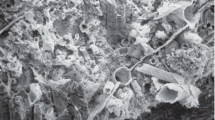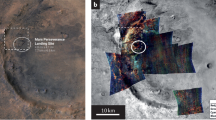This section contains images of the various types of contaminants and artefacts that may be confused for ancient life in early Archean rocks. Contaminants may be introduced by hydrothermal and metamorphic fluids at various stages throughout the (often complex) history of the host rock unit, or they may be introduced by weathering whenever the rock unit is exposed at or near the surface of the Earth. Contaminants may be very young indeed, introduced by modern soils or microbes, or even from human activity during sample collection, processing and preparation.
Various inorganic structures can also be confused for ancient life. In the main, these are purely chemical precipitates that can be misinterpreted as microfossils and/or biological stromatolites. Some types of physical sedimentary (e.g., ripples) and deformational structures (e.g., micro-folds) can also be mistaken for biological stromatolites, whilst non-biological processes can mimic biological isotope signatures (see also Fig. A35).
Access this chapter
Tax calculation will be finalised at checkout
Purchases are for personal use only
Preview
Unable to display preview. Download preview PDF.
Similar content being viewed by others
Recommended Reading
Allwood, A. C., Walter, M. R., Kamber, B. S., Marshall, C. P., and Burch, I. W., 2006, Stromatolite reef from the Early Archaean era of Australia, Nature 441: 714–718.
Awramik, S. M., Schopf, J. W., and Walter M. R., 1983, Filamentous fossil bacteria from the Archaean of Western Australia, Precambrian Research 20: 357–374.
Brasier, M. D., Green, O. R., Jephcoat, A. P., Kleppe, A. K., Van Kranendonk, M. J., Lindsay, J. F., Steele, A., and Grassineau N. V. , 2002, Questioning the evidence for Earth's oldest fossils, Nature 416: 76–81.
Brasier, M. D., Green, O. R., Lindsay, J. F., and Steele, A., 2004, Earth's oldest ( ~ 3.5 Ga) fossils and the “Early Eden” hypothesis: questioning the evidence, Origins of Life and Evolution of the Biosphere 34: 257–269.
Brasier, M. D., Green, O. R., Lindsay, J. F., McLoughlin, N., Steele, A., and Stoakes, C., 2005,Critical testing of Earth's oldest putative fossil assemblage from the ~ 3.5 Ga Apex Chert, Chinaman Creek Western Australia, Precambrian Research 140, 55–102.
Brasier, M. D., McLoughlin, N., and Wacey, D., 2006, A fresh look at the fossil evidence for early Archaean cellular life, Philosophical Transactions of the Royal Society B 361: 887–902.
Brasier, M. D., Green, O. R., Lindsay, J. F., McLoughlin, N., Stoakes, C. A., Brasier, A., and Wacey, D., 2008, Earth's oldest putative fossil assemblage from the ~ 3.5Ga Apex chert, Chinaman Creek, Western Australia: a field and petrographic guide, Geological Survey of Western Australia Record
Buick, R., 1990, Microfossil recognition in Archaean rocks: an appraisal of spheroids and filaments from a 3500 MY old chert-barite unit at North Pole, Western Australia, Palaios 5: 441–459.
Engel, A. E. J., Nagy, B., Nagy, L. A., Engel, C. G., Kremp, G. O. W., and Drew, C. M., 1968, Algal-like forms in Onverwacht Series, South Africa: oldest recognised lifelike forms on Earth, Science 161: 1005–1008.
García-Ruiz, J. M., Hyde, S. T., Carnerup, A. M., Christy, A. G., Van Kranendonk, M. J., and Welham, N. J., 2003, Self-assembled silica carbonate structures and detection of ancient microfossils, Science 302: 1194–1197.
Grotzinger, J. P., and Rothman, D. H., 1996, An abiotic model for stromatolite morphogenesis, Nature 383: 423–425.
Hofmann, H. J., Grey, K., Hickman, A. H., and Thorpe, R.I., 1999, Origin of 3.45 Ga Coniform Stromatolites in the Warrawoona Group, Western Australia, Bulletin of the Geological Society of America 111: 1256–1262.
Holm, N. G., and Charlou, J. L., 2001, Initial indications of abiotic formation of hydrocarbons in the Rainbow ultramafic hydrothermal system, Mid-Atlantic Ridge, Earth and Planetary Science Letters 191: 1–8.
Horita, J., and Berndt, M. E., 1999, Abiogenic methane formation and isotopic fractionation under hydrothermal conditions, Science 285: 1055–1057.
Hyde, S. T., Carnerup, A. M., Larsson, A. K., Christy, A. G., and Garcia-Ruiz, J. M., 2004, Self-assembly of carbonate-silica colloids: between living and non-living form, Physica 339: 24–33.
Lowe, D. R., Byerly, G. R., Kyte, F. T., Shukloyokov, A., Asaro, F., and Krull, A., 2003, Early Archean spherule beds 3.47–3.34 Ga old in the Barberton greenstone belt, South Africa: a record of large meteor impacts and their influence on early crustal and biological evolution, Astrobiology 3: 7–48.
McCollum, T. M., and Seewald, J. S., 2006, Carbon isotope composition of organic compounds produced by abiotic synthesis under hydrothermal conditions, Earth and Planetary Science Letters 243: 74–84.
Oehler, J. H., 1976, Hydrothermal crystallization of silica gel, Bulletin of the Geological Society of America 87: 1143–1152.
Sherwood Lollar, B., Westagate, T. D., Ward, J. A., Slater, G. F., and Lacrampe-Couloume, G., 2002, Abiogenic formation of alkanes in the Earth's crust as a minor source for global hydrocarbon reservoirs, Nature 416: 522–524.
Simonson, B. M., 2003, Petrographic criteria for recognizing certain types of impact spherules in well preserved Precambrian successions, Astrobiology 3: 49–64.
Westall, F., and Folk, R. L., 2003, Exogenous carbonaceous microstructures in Early Archaean cherts and BIFs from the Isua Greenstone Belt: implications for the search for life in ancient rocks, Precambrian Research 126: 313–330.
Yanagisawa, K., Feng, Q., and Yamasaki, N., 1997, Hydrothermal synthesis of xonotlite whiskers by ion diffusion, Journal of Materials Science Letters 16: 889–891.
Editor information
Editors and Affiliations
Rights and permissions
Copyright information
© 2009 Springer Science + Business Media B.V.
About this chapter
Cite this chapter
(2009). THE IMPOSTERS: Younger Biological Contaminants and Non-Biological Artefacts. In: Wacey, D. (eds) Early Life on Earth. Topics in Geobiology, vol 31. Springer, Dordrecht. https://doi.org/10.1007/978-1-4020-9389-0_22
Download citation
DOI: https://doi.org/10.1007/978-1-4020-9389-0_22
Publisher Name: Springer, Dordrecht
Print ISBN: 978-1-4020-9388-3
Online ISBN: 978-1-4020-9389-0
eBook Packages: Earth and Environmental ScienceEarth and Environmental Science (R0)




